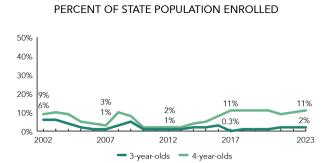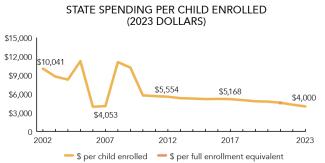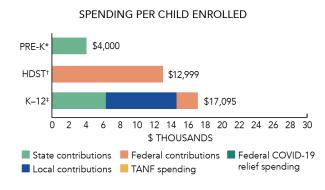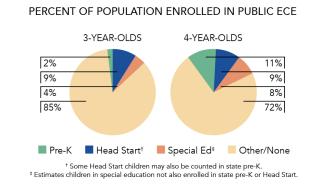
State of Preschool
Access Rankings
Resource Rankings
Total Benchmarks Met
Overview

During the 2022-2023 school year, Ohio preschool enrolled 18,000 children, an increase of 1,268 from the prior year. State spending totaled $72,000,000, up $585,889 (1%), adjusted for inflation, since last year. State spending per child equaled $4,000 in 2022-2023, down $268 from 2021-2022, adjusted for inflation. Ohio met 5 of 10 quality standards benchmarks.
What's New

In August 2023, the State lifted the requirement to obtain pre-approval for 3-year-old children to enroll in the Ohio Early Childhood Education (ECE), making it the same as 4-year-old children. The State also increased the budget for the ECE program, effectively doubling the number of children who will be served in the 2023-2024 School Year. The Ohio ECE program is also running a pilot study in the 2023-2024 school year. The study examines the access and participation of children exiting early intervention without preschool special education eligibility to a publicly funded preschool slot.
The Ohio Department of Job and Family Services (ODJFS) received a three-year, $16 million per year ($48 million total) Preschool Development Grant Birth through Five (PDG B–5) renewal grant in December of 2022 to support and increase access to quality early childhood care and education. ODJFS is partnering with the Ohio Departments of Education; Health; Mental Health and Addiction Services; Medicaid; and Developmental Disabilities to administer the grant programs.
Background
The Ohio Public Preschool Program (PSP), established in 1990 following a four-year pilot program, strives to ensure children have access to quality programs through public preschool and publicly funded childcare. All types of programs have access to both public preschool and childcare funds. This report focuses on the Ohio Department of Education’s publicly funded Early Childhood Education (ECE) program, excluding publicly funded childcare and Head Start programs.
Ohio is operating its publicly funded programs under common program and child standards. All Ohio ECE programs are required to be rated at 3 or more stars on the state’s quality rating and improvement system (QRIS).
Program sites are monitored annually for quality via desk audits, internal monitoring materials, proposal of plans, and documentation, along with annual licensing visits, classroom observations, and child assessments. Ohio began using an expanded tiered QRIS in 2013-2014 for all state programs, including public preschool and childcare programs. Programs are required to submit annual documentation of meeting or exceeding standards, including annual classroom observations of quality and regular on-site visits.
Ohio Early Childhood Education
Access
Resources
| Total state pre-K spending | $72,000,000 |
| Local match required? | No |
| State Head Start spending | $0 |
| State spending per child enrolled | $4,000 |
| All reported spending per child enrolled* | $4,000 |

*Pre-K programs may receive additional funds from federal or local sources that are not included in this figure. †Head Start per-child spending includes funding only for 3- and 4-year-olds. ‡K–12 expenditures include capital spending as well as current operating expenditures.
Ohio Quality Standards Checklist
| Policy | Requirement | Benchmark | Meets Benchmark? |
|---|---|---|---|
For more information about the benchmarks, see the Executive Summary and the Roadmap to State pages. | 5benchmarks met | ||
| Early Learning & Development Standards Benchmark | Comprehensive, aligned, supported, culturally sensitive | Comprehensive, aligned, supported, culturally sensitive | |
| Curriculum Supports Benchmark | Approval process & supports | Approval process & supports | |
| Teacher Degree Benchmark | AA | BA | |
| Teacher Specialized Training Benchmark | ECE, CD, ECE SpEd (public); ECE, CD (nonpublic) | Specializing in pre-K | |
| Assistant Teacher Degree Benchmark | HSD | CDA or equivalent | |
| Staff Professional Development Benchmark | 20 hours/2 years; PD plans | For teachers & assistants: At least 15 hours/year; individual PD plans; coaching | |
| Maximum Class Size Benchmark | 24 (3-year-olds); 28 (4-year-olds) | 20 or lower | |
| Staff to Child Ratio Benchmark | 1:12 (3-year-olds); 1:14 (4-year-olds) | 1:10 or better | |
| Screening & Referral Benchmark | Vision, hearing, health & more | Vision, hearing & health screenings; & referral | |
| Continuous Quality Improvement System Benchmark | Structured classroom observations; Data used for program improvement | Structured classroom observations; data used for program improvement | |
